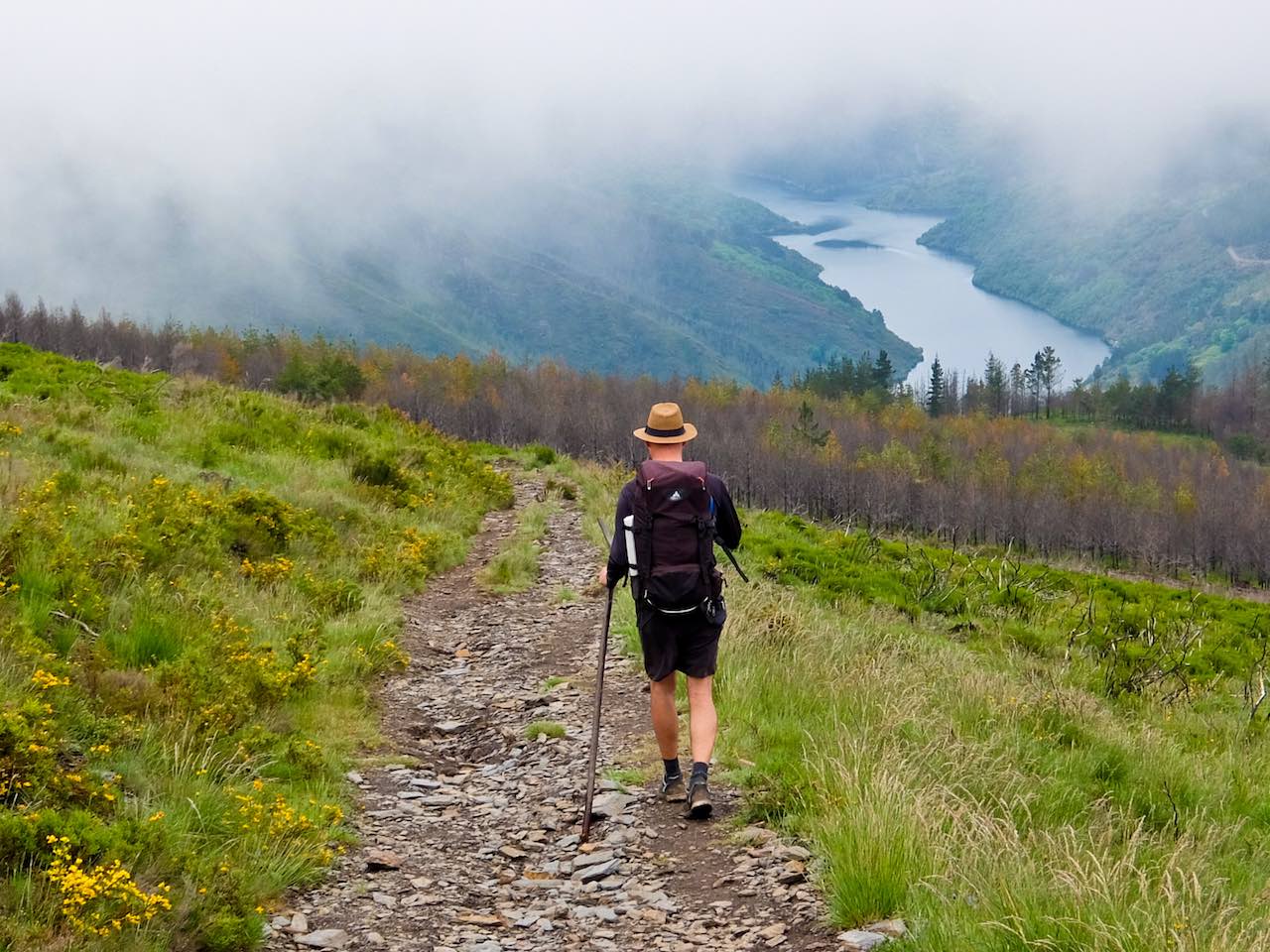It was King Alfonso the Chaste, in 814, who first made the 342km pilgrimage from the city of Oviedo, in Asturias, to Santiago de Compostela in Galicia. Ever since then, pilgrims have been making their way on foot (and cycle) to the great cathedral at Santiago by various “Ways”, the most popular being the Camino Frances, or the French Way. These days it’s difficult to avoid the crowds so the Camino Primitivo, running through remote areas of Asturias, and relatively unknown, is particularly attractive.
Oviedo to Grado
Oviedo was the capital of Christian Spain, when most of it was occupied by the moors and the construction of its Cathedral spans eight centuries. Around it there’s a charming network of medieval streets with shops, restaurants and a huge covered market, perfect for stocking up on supplies.

Misty Morning (c) Rupert Parker
The weather is grey, slightly damp but I climb out of the city to find delightful woodland tracks which take me to Grado and my Inn, just outside in the tiny village of Rodiles. Marta, the owner, serves up delicious food from her garden and tells me that Asturias is a neglected region of Spain. Young people are leaving for the cities and the population is decreasing dramatically. Their place is being taken by wild beasts, including bears and wolves, are moving in.
READ ALSO: Hotel Review: Las Caldas Villa Termal, Oviedo, Spain
Grado to Salas
Next day, wary of dangerous animals, I pass many of the distinctive rectangular grain stores standing on pillars. These days the maize is sent straight to market so most of these “Horreos” are empty. The government is keen to preserve them but, strangely won’t allow them to be used as extra bedrooms.

Horreo (c) Rupert Parker
There’s a lot of road walking today, but at least there’s little traffic and I arrive at the attractive town of Salas to find I’m staying in the Castillo, a little castle adjoining the town’s main gate.
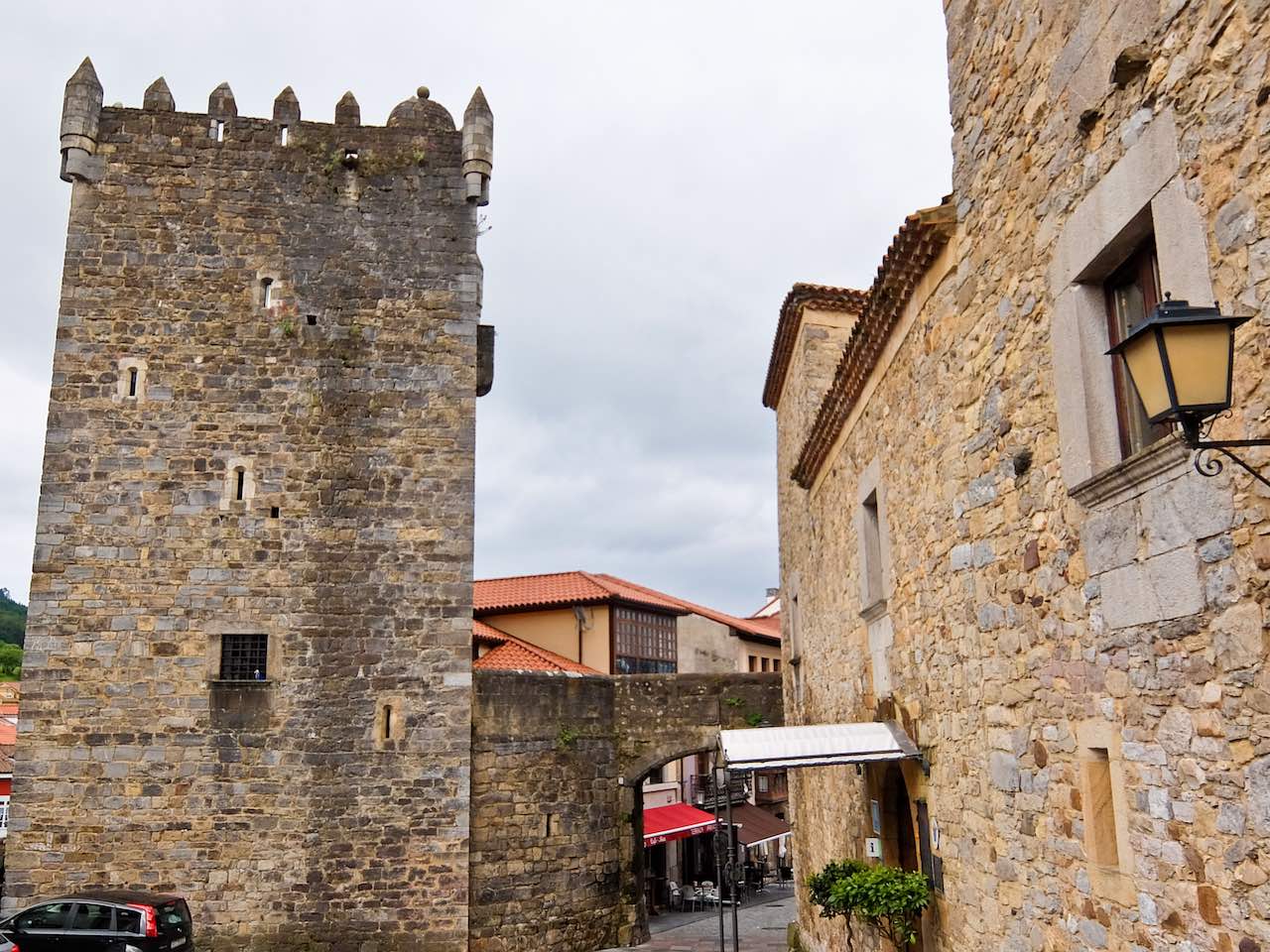
Salas (c) Rupert Parker
There’s also an Asturian Renaissance church, apparently a masterpiece, but like most churches, it’s locked so I can’t visit.
Salas to Tineo
The morning brings sun and a long uphill climb to around 650m through fields covered in spring flowers. As if to emphasise the starkness of the landscape, there’s an Autopista running on stilts beside me. The regular hum of car engines disturbs the silence, but at least it takes the traffic away from the roads I’m walking.
I continue on tracks made muddy by cows, and see solitary women tending their flocks of sheep. Life here seems to have remained the same for centuries, and people still sport traditional wooden clogs. Tineo is a gaunt town, straddling the hillside, full of old people and empty buildings, but a decent spot to spend the night.
Walk the Camino Primitivo
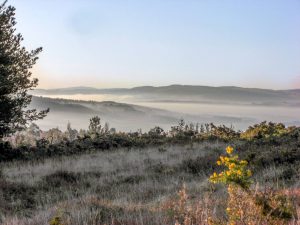
We recommend using Follow The Camino to assist you in planning your walking holiday on the Camino Primitivo (Original Way).
Follow The Camino provides customised itineraries to suit you. You decide if you want a guided or self-guided package, when to go, what distance you want to cover each day, and if you want to travel solo, in a group or with family or friends.
Tineo to Berducedo
Today is market day but I’m keen to get on as the sun is shining. I have a choice whether to descend to the valley through Pola de Allande or the high-level Hospitales Route. The guidebook says this is the most demanding section of any Camino but also the most rewarding. It’s so isolated that three hospitals were built to give shelter to pilgrims.

Hospitales Route (c) Rupert Parker
It should be avoided in bad weather but it’s so clear that I’m rewarded by glorious views as I climb beyond the treeline. I see nobody and these days, the hospitals are nothing more than piles of rubble. Further on are the remains of a Roman gold mine with small reservoirs, canals and tunnels and I finally reach Puerto del Palo, at 1146m, the highest point on the route. From here it’s a steep descent to Berducedo, a tiny village, so remote there’s no phone signal.
Berducedo to Embalse de Salime
In the morning, there’s thick mist, just the sort of weather that I’m glad I avoided yesterday. After an hour, the sun burns through, and the path takes me through thick forest, recently devastated by fire. The blackened trees allow me glorious views of the Embalse de Salime, a lake formed by damming the Rio Navia, down below.
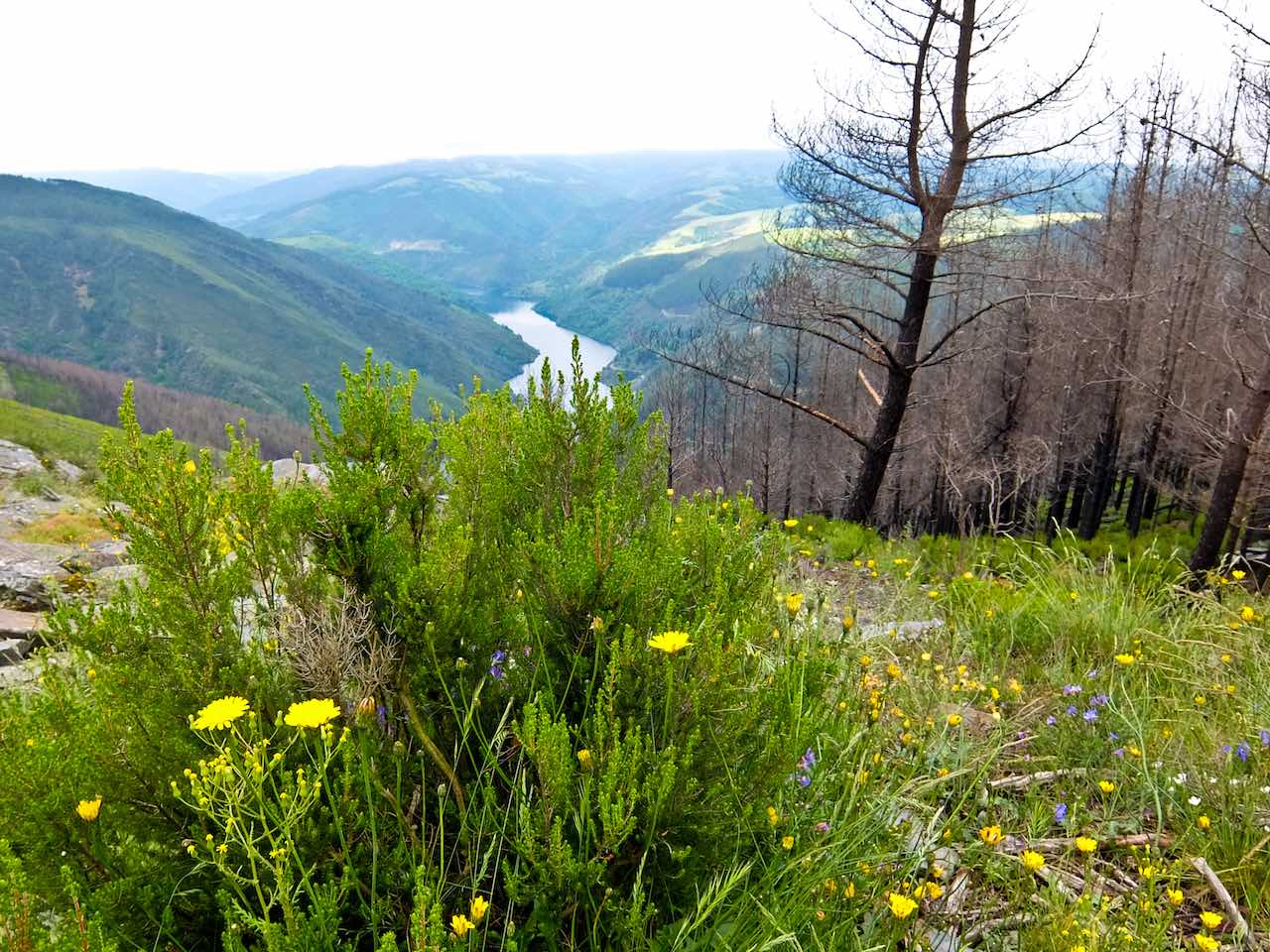
Embalse de Salime (c) Rupert Parker
Construction of this hydroelectric project began in 1946, and, when it opened in 1955, the reservoir was largest in Spain and second largest in Europe. It needed 3000 workers and I can still make out their abandoned houses on the hillside. The Hotel Grandas, just above the lake, was once the manager’s office and has wonderful views from its terrace.
Embalse de Salime to A Fonsagrada
Next day, I follow the lake before climbing up to Grandas de Salime, an attractive village with a 12th century church. From here it’s upwards to an array of wind turbines, and I surprise a deer who beats a hasty retreat. Laid out of front of me is a carpet of vivid red heather and yellow gorse, and I’m leaving Asturias and entering Galicia.
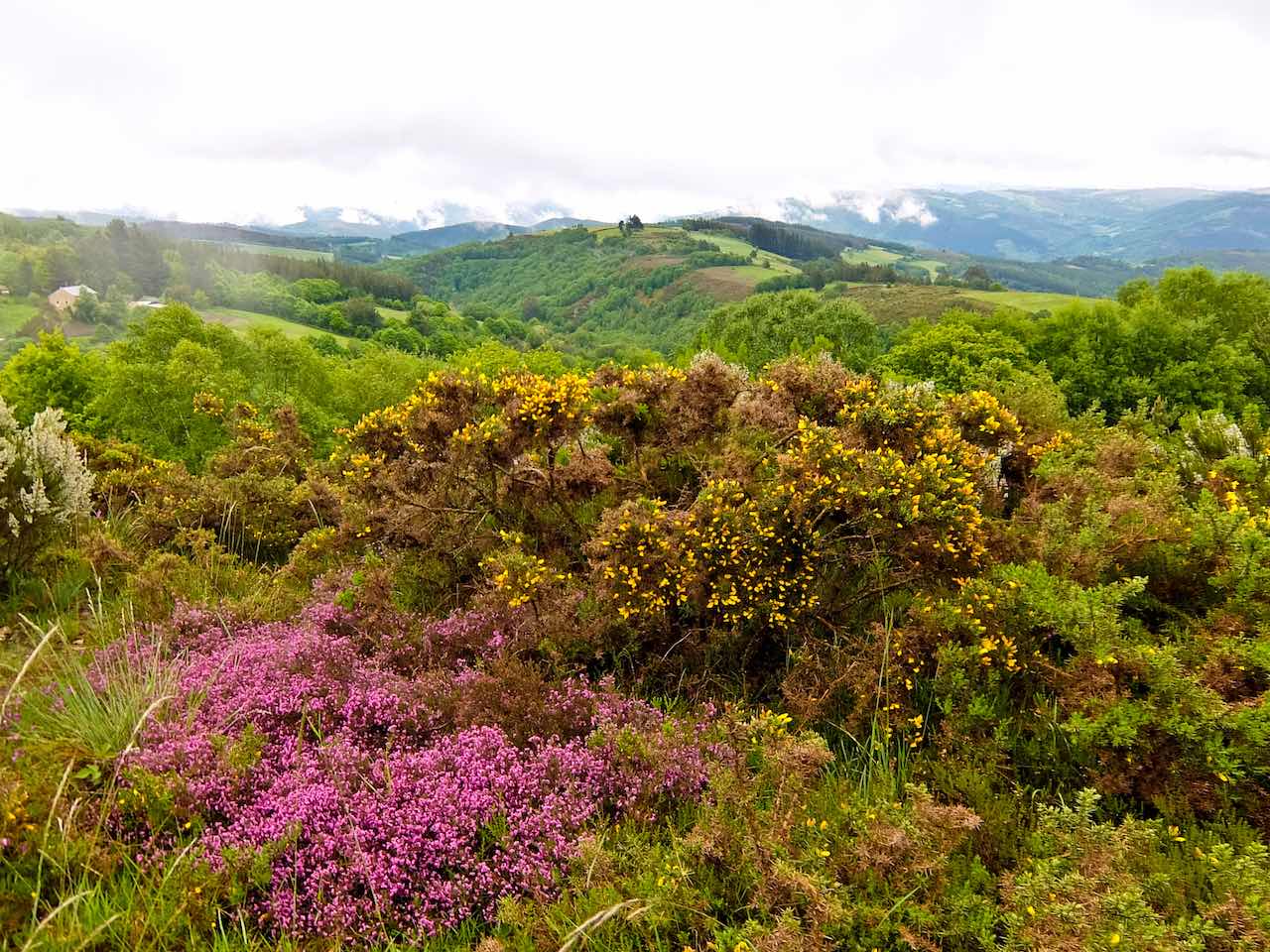
Red heather and yellow gorse (c) Rupert Parker
I may be dreaming, but the landscape really does seem to change. It becomes more manicured, less wild, and the mountains lose their sharp edges. I arrive in A Fonsagrada where legend has it that St James came here and turned the water in the fountain to milk. There’s no sign of that now, but they’re celebrating Corpus Christi with a rock band playing Spanish hits, on a huge stage in the square. The pubs are heaving and I take the opportunity celebrate my arrival in Galicia.
A Fonsagrada to Lugo
Overnight the weather turns and it’s a damp trek up to the 14th century Pilgrim Hospital of Montouto. Unlike the others I’ve seen, this is reasonably intact, probably because it functioned into the early 20th century. It’s a place to shelter from the rain and admire the Neolithic dolmen nearby, almost invisible in the mist.

Neolithic Dolmen (c) Rupert Parker
I pass through a number of dry stone Galician villages, looking like they’ve been carved into the landscape before arriving at O Cadavo Baleira. Apparently Alphonso the Chaste battled the Moors here, protecting the pilgrimage route.
It pours down all the way down to Lugo, one of the most impressive cities on the whole route. The Romans built its massive walls, now a UNESCO World Heritage site, and you can walk the 2km circuit, admiring the 12th century Cathedral of Santa Maria, a fine mix of Romanesque, Gothic, Baroque, Rococo and Neo-Classical.

Lugo Walls (c) Rupert Parker
I decide this is a good place to end my journey. There are only two more stages before it joins the Camino Frances, which I’ve already walked, and the weather is grim. It’s certainly been tougher than the other routes but there’s less road walking and I’ve had the path to myself most of the time. Best of all, the few pilgrims I have met have been Camino veterans, all of whom I look forward to seeing again.
READ ALSO: Camino de Santiago: The French Way (Camino Francés)
READ ALSO: Camino de Santiago: Finisterre Way (Camino de Fisterra)
Fact File
FLY: Vueling flies direct to Asturias from Gatwick three times a week.
PACKAGE: Follow the Camino organise self-guided tours on the Camino de Santiago, including the Camino Primitivo. A 10-night self-guided tour walking from Oviedo to Lugo starts at approximately £890 per person sharing including accommodation, breakfast, 8 dinners, luggage transfers, holiday pack with practical information and 24/7 assistance number. Airport transfers and hotel upgrades in the bigger towns are also available.
GUIDE: Cicerone’s The Northern Caminos includes a step by step guide to the Camino Primitivo.
Disclaimer: this article was sponsored by One Foot Abroad

